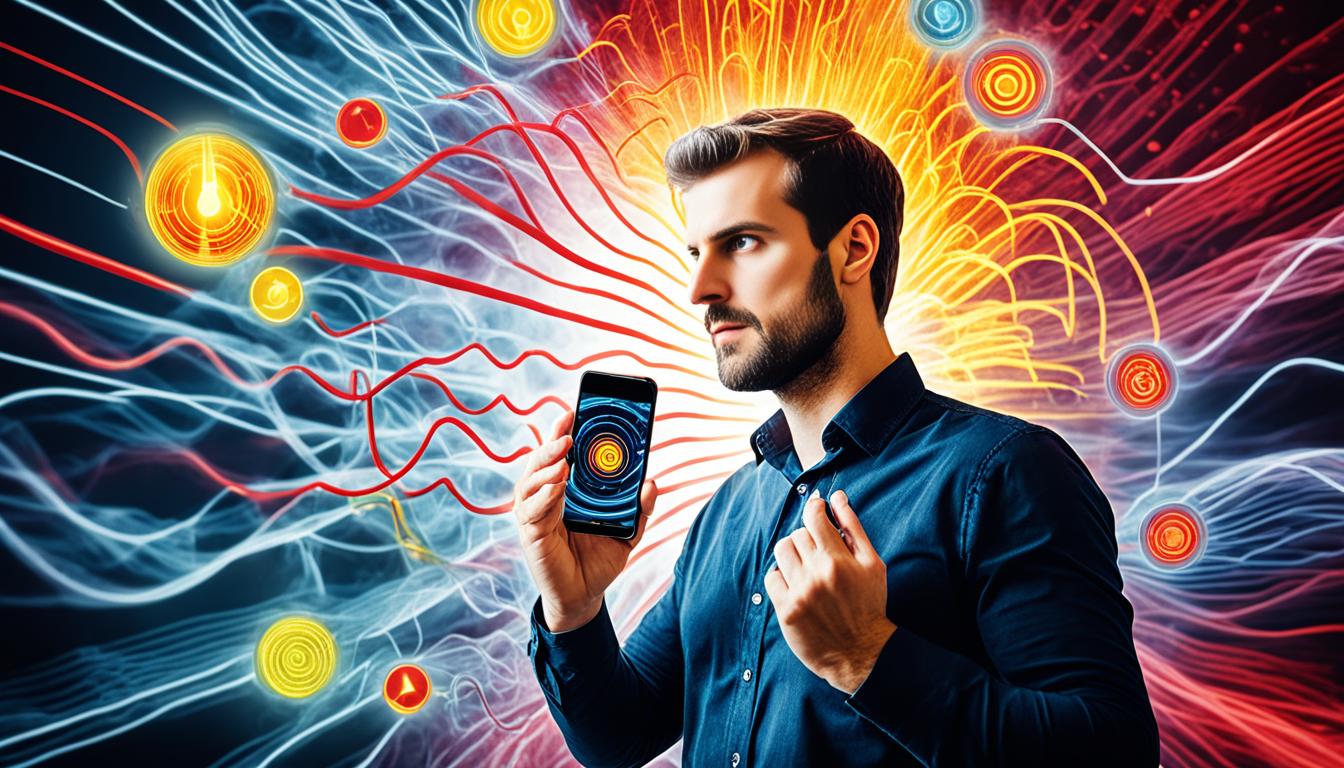Disclosure: This Post Contains Affiliate Links; We earn a commission on purchases.
The rapid advancement of technology has revolutionized numerous industries, and the mobile device industry is no exception. As technological innovation continues to push boundaries, it is important to consider the potential implications on human health, particularly in relation to electromagnetic field (EMF) emissions.
EMF exposure risks have garnered significant attention as mobile devices become more prevalent in our daily lives. The cutting-edge technology embedded in these devices generates electromagnetic radiation, raising concerns about potential dangers to human well-being.
Understanding the impact of emerging technologies on EMF emissions is crucial in order to address these concerns effectively. By evaluating the potential risks associated with advanced technology, we can develop strategies to protect individuals and mitigate any adverse effects.
Key Takeaways:
- Emerging technologies in the mobile device industry have raised concerns regarding EMF emissions.
- Advanced technology generates electromagnetic radiation, which may pose risks to human health.
- Evaluating the impact of emerging technologies on EMF emissions is essential for developing effective risk mitigation strategies.
- Understanding the potential risks associated with advanced technology can lead to the development of safer and more innovative technologies.
- Addressing EMF exposure risks is crucial for safeguarding public health.
Understanding EMF Emissions from Mobile Devices
Mobile phones have revolutionized the way we communicate, providing us with instant connectivity and convenient access to information. However, as we increasingly rely on these devices, concerns about electromagnetic field (EMF) emissions and their potential effects on human health have emerged.
“Mobile phones operate by transmitting radio waves through base stations. These radiofrequency waves are a form of electromagnetic fields (EMFs) that do not have the same ionizing properties as X-rays or gamma rays.”
When we make calls or use data services on our mobile phones, they emit low-powered radiofrequency waves in the form of electromagnetic fields. These waves have frequencies ranging from 450 to 2700 MHz, which are much lower than the frequencies of ionizing radiation like X-rays or gamma rays.
It’s important to note that the power and exposure to radiofrequency waves decrease with the distance of the device from our bodies. So holding the phone away from the body, using hands-free devices, or opting for speaker mode can help minimize exposure to EMFs.
EMF Exposure Risks
While the majority of research indicates that low-level exposure to EMFs from mobile devices does not pose significant risks to human health, there are still ongoing studies and discussions in the scientific community.
To date, studies have not found any established adverse health effects directly caused by mobile phone use or exposure to EMFs. Research suggests that the principal mechanism of interaction between radiofrequency energy and the body is tissue heating, primarily affecting the skin and superficial tissues.
“Various factors, such as using hands-free devices and limiting call duration, can minimize exposure to EMFs.”
Electromagnetic Radiation Dangers
While it is essential to continue evaluating the potential risks associated with EMF exposure, current evidence does not consistently show a causal relationship between exposure to electromagnetic fields and adverse health effects. Furthermore, studies examining self-reported symptoms of electromagnetic hypersensitivity have also not established a direct connection.
| Concern | Research Findings |
|---|---|
| Tissue Heating | Interactions between radiofrequency energy and the human body primarily lead to tissue heating, affecting the skin and superficial tissues. |
| Adverse Health Effects | No consistent evidence of adverse health effects directly caused by exposure to electromagnetic fields from mobile devices. |
| Electromagnetic Hypersensitivity | No conclusive evidence establishing a causal relationship between exposure to electromagnetic fields and self-reported symptoms. |
While it’s necessary to remain cautious and continue monitoring developments in electromagnetic radiation research, it’s important to base our understanding on scientific evidence and avoid unnecessary alarm.
Having a clear understanding of how EMFs are emitted by mobile devices and the current state of research helps us make informed decisions about their use, taking necessary precautions to minimize potential risks. In the next section, we will explore the findings from various health studies and address common concerns related to EMF exposure.
Health Concerns and Research Findings
With the widespread use of mobile phones and exposure to electromagnetic fields (EMFs), there have been concerns regarding potential health risks. Extensive research has been conducted to assess these concerns, focusing on the effects of mobile phone use and exposure to EMFs. So far, no adverse health effects have been established as being caused by mobile phone use.
One of the principal mechanisms of interaction between radiofrequency energy and the human body is tissue heating, which primarily affects the skin and superficial tissues. However, research does not consistently provide evidence of adverse health effects resulting from exposure to radiofrequency fields. While mobile phones do emit radiofrequency waves, the levels of exposure decrease with distance from the handset.
“The potential risks associated with electromagnetic fields (EMFs) and mobile phone use have been extensively studied, with consistent findings indicating no established adverse health effects.”
“To date, research does not provide consistent evidence of adverse health effects from exposure to radiofrequency fields or a causal relationship between exposure to electromagnetic fields and self-reported symptoms of electromagnetic hypersensitivity.”
Studies have also investigated the existence of electromagnetic hypersensitivity, a condition where individuals report symptoms, such as headaches and fatigue, due to exposure to electromagnetic fields. However, research has not found a causal relationship between exposure to electromagnetic fields and these self-reported symptoms of electromagnetic hypersensitivity.
It is important to note that the scientific community continues to conduct research on the potential health risks associated with EMF exposure and mobile phone use. Ongoing studies aim to further understand the long-term effects of EMFs and their potential impact on human health. While it is essential to remain aware of health concerns, current research indicates that there are no established adverse health effects resulting from mobile phone use or exposure to EMFs.
Table 1: Summary of Research Findings
| Topic | Research Findings |
|---|---|
| Tissue Heating | No adverse health effects have been established, as tissue heating primarily affects superficial tissues. |
| Radiofrequency Field Exposure | Research does not provide consistent evidence of adverse health effects from exposure to radiofrequency fields. |
| Electromagnetic Hypersensitivity | No causal relationship has been found between exposure to electromagnetic fields and self-reported symptoms of electromagnetic hypersensitivity. |
Long-term Risks and Ongoing Research
Epidemiological studies have primarily focused on assessing the potential long-term risks of mobile phone use, particularly the association between mobile phone use and brain tumors. However, due to the latency period of tumor development and the relatively recent widespread use of mobile phones, research has primarily focused on evaluating shorter-term risks. Animal studies have consistently shown no increased cancer risk from long-term exposure to radiofrequency fields.
“Animal studies have consistently shown no increased cancer risk from long-term exposure to radiofrequency fields.”
Despite the current evidence, ongoing and future research will continue to explore the long-term impact of mobile phone use on brain cancer risk, with particular emphasis on younger individuals who may have a longer lifetime exposure to mobile devices.
“Ongoing and future research will focus on long-term mobile phone use and its potential impact on brain cancer risk, particularly among younger individuals.”
By conducting comprehensive epidemiological studies, researchers aim to better understand the long-term risks associated with mobile phone use and provide evidence-based recommendations for safe and responsible mobile device usage.
The Importance of Epidemiological Studies
Epidemiological studies play a crucial role in evaluating the potential risks and benefits of mobile phone use. By observing large populations over extended periods, researchers can identify any potential associations between mobile phone use and adverse health outcomes like brain tumors. These studies provide valuable insights into the long-term effects of mobile phone use and help inform public health policies and guidelines.
“Epidemiological studies provide valuable insights into the long-term effects of mobile phone use and help inform public health policies and guidelines.”
Global Regulatory Guidelines and Assessments
Ensuring the safety of individuals in relation to electromagnetic field (EMF) exposure is a global concern. International bodies, such as the International Commission on Non-Ionizing Radiation Protection (ICNIRP) and the Institute of Electrical and Electronics Engineers (IEEE), have developed rigorous exposure limits and guidelines for radiofrequency electromagnetic fields. These guidelines are established based on extensive scientific evidence and are aimed at safeguarding the well-being of both workers and the general public.
One of the leading organizations working towards assessing the potential health effects of EMFs is the World Health Organization (WHO). The WHO has initiated the International Electromagnetic Fields (EMF) Project, which conducts comprehensive research assessments and develops public information materials to raise awareness and enhance understanding of the potential risks associated with EMF exposure.
Specific Absorption Rate (SAR)
One of the parameters used to assess the potential impact of mobile devices on human health is the Specific Absorption Rate (SAR). SAR measures the rate at which energy is absorbed by the human body when exposed to radiofrequency electromagnetic fields. International guidelines have established SAR limits to ensure that the exposure to electromagnetic radiation from mobile devices remains within safe levels.
“Our guidelines are based on the latest scientific evidence and are designed to protect individuals from excessive exposure to electromagnetic fields. By establishing SAR limits, we strive to mitigate potential health risks.” – Dr. Christopher Davis, ICNIRP Chairman
International Guidelines and Standards
The ICNIRP and the IEEE have set international guidelines and standards to regulate the permissible levels of EMF exposure. These guidelines consider various factors such as frequency, distance, and exposure duration to determine safe exposure limits. By adhering to these guidelines, countries worldwide have implemented regulations to minimize the potential health risks associated with EMFs.
WHO Research and Awareness
The WHO’s International Electromagnetic Fields (EMF) Project plays a vital role in assessing the potential health effects of EMFs and promoting global awareness. Through ongoing research, the WHO continuously evaluates emerging scientific evidence to improve understanding and provide guidance on the safe use of technology. The project collaborates with experts, scientists, and policymakers from around the world to ensure that public health remains a top priority.

Mobile Health Technologies and Their Impact
Mobile health technologies, such as mHealth apps, have revolutionized the healthcare industry by promoting health behavior change and facilitating chronic medication adherence. By leveraging the convenience and accessibility of mobile devices, these digital interventions have shown promising results in improving various aspects of healthcare.
MHealth apps empower individuals to take control of their health by providing personalized tools and resources right at their fingertips. These apps offer features such as medication reminders, symptom tracking, and health coaching, which can positively influence health behaviors and lead to better health outcomes.
For instance, in the field of cardiovascular disease prevention, mHealth apps have been used to encourage regular physical activity, monitor blood pressure and cholesterol levels, and promote healthy eating habits.
“By integrating mobile health technologies into clinical practice, healthcare providers can effectively support patients in making positive lifestyle changes and adhering to their chronic medication regimens.”
Similarly, mHealth apps have proven to be effective in smoking cessation programs, providing users with quit plans, tracking their progress, and offering motivation and support along the way. These apps leverage features such as goal setting, social support communities, and real-time progress tracking to enhance the chances of successful smoking cessation.
Moreover, mHealth apps play a crucial role in improving adherence to chronic medication. These apps remind patients to take their medications on time, provide information about medication dosage and side effects, and enable users to track their medication intake. By addressing barriers to medication adherence through personalized interventions, mHealth apps have the potential to enhance treatment outcomes for individuals managing chronic conditions.
The implementation and evaluation of mHealth apps have become essential for enhancing population health and addressing healthcare challenges. These technologies have the potential to revolutionize healthcare delivery by empowering individuals to take charge of their health and promoting positive behavior change.

| Benefits of mHealth Apps | Examples |
|---|---|
| Improved medication adherence | Medisafe, Mango Health |
| Enhanced chronic disease management | mySugr, Livongo |
| Behavioral health support | Headspace, Calm |
| Personalized fitness and nutrition guidance | MyFitnessPal, Lose It! |
While mobile health technologies have shown great potential, it is important to ensure their user-friendliness, efficacy, and adherence to privacy and security standards. Ongoing research and evaluation of these technologies are necessary to maximize their impact and address any limitations or concerns.
Conclusion
Emerging technologies have brought about significant advancements in the mobile device industry, transforming the way we communicate and interact. However, concerns regarding the potential health risks associated with electromagnetic field (EMF) emissions persist. Current research indicates that there are no established adverse effects from mobile phone use or exposure to EMFs.
Nevertheless, it is crucial to continue conducting future research to comprehensively assess long-term risks, particularly in relation to the risk of brain cancer. This ongoing research will provide valuable insights into the potential impacts of EMF emissions on public health, enabling the development of effective public health policies.
Regulatory guidelines have been established to protect individuals from excessive EMF exposure. Organizations such as the World Health Organization (WHO) are actively involved in assessing and communicating potential risk factors associated with EMFs. Their work plays a vital role in informing public health policies and promoting the development of safe and innovative technologies.
By deepening our understanding of the impact of emerging technologies on EMF emissions, we can establish effective public health policies that strike a balance between technological advancements and the protection of public health. The continued collaboration between researchers, industry leaders, and policymakers will be instrumental in ensuring that our use of mobile devices remains safe and sustainable in the years to come.
Source Links
- https://www.who.int/news-room/fact-sheets/detail/electromagnetic-fields-and-public-health-mobile-phones
- https://www.ncbi.nlm.nih.gov/pmc/articles/PMC7281144/
- https://cordis.europa.eu/article/id/87844-how-do-emerging-technologies-affect-our-health

Subscribe to Our Newsletter










